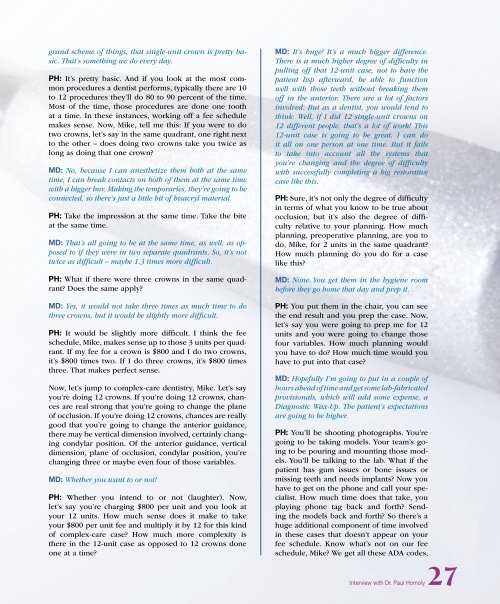PDF Version - Glidewell Dental Labs
PDF Version - Glidewell Dental Labs
PDF Version - Glidewell Dental Labs
Create successful ePaper yourself
Turn your PDF publications into a flip-book with our unique Google optimized e-Paper software.
grand scheme of things, that single-unit crown is pretty basic.<br />
That’s something we do every day.<br />
PH: It’s pretty basic. And if you look at the most common<br />
procedures a dentist performs, typically there are 10<br />
to 12 procedures they’ll do 80 to 90 percent of the time.<br />
Most of the time, those procedures are done one tooth<br />
at a time. In these instances, working off a fee schedule<br />
makes sense. Now, Mike, tell me this: If you were to do<br />
two crowns, let’s say in the same quadrant, one right next<br />
to the other – does doing two crowns take you twice as<br />
long as doing that one crown?<br />
MD: No, because I can anesthetize them both at the same<br />
time, I can break contacts on both of them at the same time<br />
with a bigger bur. Making the temporaries, they’re going to be<br />
connected, so there’s just a little bit of bisacryl material.<br />
PH: Take the impression at the same time. Take the bite<br />
at the same time.<br />
MD: That’s all going to be at the same time, as well, as opposed<br />
to if they were in two separate quadrants. So, it’s not<br />
twice as difficult – maybe 1.3 times more difficult.<br />
PH: What if there were three crowns in the same quadrant?<br />
Does the same apply?<br />
MD: Yes, it would not take three times as much time to do<br />
three crowns, but it would be slightly more difficult.<br />
PH: It would be slightly more difficult. I think the fee<br />
schedule, Mike, makes sense up to those 3 units per quadrant.<br />
If my fee for a crown is $800 and I do two crowns,<br />
it’s $800 times two. If I do three crowns, it’s $800 times<br />
three. That makes perfect sense.<br />
Now, let’s jump to complex-care dentistry, Mike. Let’s say<br />
you’re doing 12 crowns. If you’re doing 12 crowns, chances<br />
are real strong that you’re going to change the plane<br />
of occlusion. If you’re doing 12 crowns, chances are really<br />
good that you’re going to change the anterior guidance,<br />
there may be vertical dimension involved, certainly changing<br />
condylar position. Of the anterior guidance, vertical<br />
dimension, plane of occlusion, condylar position, you’re<br />
changing three or maybe even four of those variables.<br />
MD: Whether you want to or not!<br />
PH: Whether you intend to or not (laughter). Now,<br />
let’s say you’re charging $800 per unit and you look at<br />
your 12 units. How much sense does it make to take<br />
your $800 per unit fee and multiply it by 12 for this kind<br />
of complex-care case? How much more complexity is<br />
there in the 12-unit case as opposed to 12 crowns done<br />
one at a time?<br />
MD: It’s huge! It’s a much bigger difference.<br />
There is a much higher degree of difficulty in<br />
pulling off that 12-unit case, not to have the<br />
patient lisp afterward, be able to function<br />
well with those teeth without breaking them<br />
off in the anterior. There are a lot of factors<br />
involved. But as a dentist, you would tend to<br />
think: Well, if I did 12 single-unit crowns on<br />
12 different people, that’s a lot of work! This<br />
12-unit case is going to be great, I can do<br />
it all on one person at one time. But it fails<br />
to take into account all the systems that<br />
you’re changing and the degree of difficulty<br />
with successfully completing a big restorative<br />
case like this.<br />
PH: Sure, it’s not only the degree of difficulty<br />
in terms of what you know to be true about<br />
occlusion, but it’s also the degree of difficulty<br />
relative to your planning. How much<br />
planning, preoperative planning, are you to<br />
do, Mike, for 2 units in the same quadrant?<br />
How much planning do you do for a case<br />
like this?<br />
MD: None. You get them in the hygiene room<br />
before they go home that day and prep it.<br />
PH: You put them in the chair, you can see<br />
the end result and you prep the case. Now,<br />
let’s say you were going to prep me for 12<br />
units and you were going to change those<br />
four variables. How much planning would<br />
you have to do? How much time would you<br />
have to put into that case?<br />
MD: Hopefully I’m going to put in a couple of<br />
hours ahead of time and get some lab-fabricated<br />
provisionals, which will add some expense, a<br />
Diagnostic Wax-Up. The patient’s expectations<br />
are going to be higher.<br />
PH: You’ll be shooting photographs. You’re<br />
going to be taking models. Your team’s going<br />
to be pouring and mounting those models.<br />
You’ll be talking to the lab. What if the<br />
patient has gum issues or bone issues or<br />
missing teeth and needs implants? Now you<br />
have to get on the phone and call your specialist.<br />
How much time does that take, you<br />
playing phone tag back and forth? Sending<br />
the models back and forth? So there’s a<br />
huge additional component of time involved<br />
in these cases that doesn’t appear on your<br />
fee schedule. Know what’s not on our fee<br />
schedule, Mike? We get all these ADA codes,<br />
Interview with Dr. Paul Homoly27

















